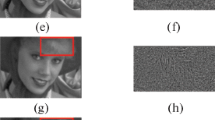We consider the choice of image denoising parameters in an algorithm based on singular decomposition and minimization of the weighted nuclear norm. An automated parameter-choosing method is proposed that analyzes the structures on a difference image between the original noisy image and the denoised result and performs a quantitative assessment of the structures — computes the mutual information coefficient. We also analyze the choice of optimal parameters for different noise levels using a database of photographic images with normally distributed simulated noise. The denoising results are compared for the optimal choice of parameters and the choice of parameters by the mutual information coefficient, and also with denoising by a Peron–Malik diffusion algorithm.
Similar content being viewed by others
References
M. Lindenbaum, M. Fischer, and A. Bruckstein, “On Gabor’s contribution to image enhancement,” Pattern Recognition, 27, No. 1, 1–8 (1994).
L. P. Yaroslavsky, Digital Picture Processing: an Introduction, Springer Science & Business Media, Vol. 9 (2012).
A. Antoniadis and G. Oppenheim, Wavelets and Statistics, Springer Science & Business Media, Vol. 103 (2012).
P. Perona and J. Malik, “Scale-space and edge detection using anisotropic diffusion,” IEEE Transactions on Pattern Analysis and Machine Intelligence, 12, No. 7, 629–639 (1990).
L. I. Rudin, S. Osher, and E. Fatemi, “Nonlinear total variation based noise removal algorithmsm,” Physica D: Nonlinear Phenomena, 60, No. 1-4, 259–268 (1992).
A. Buades, B. Coll, and J.-M. Morel, “A non-local algorithm for image denoising,” 2005 IEEE Computer Society Conference on Computer Vision and Pattern Recognition (CVPR’05), IEEE, 2, 60–65 (2005).
K. Dabov, A. Foi, V. Katkovnik, and K. Egiazarian, “Image denoising by sparse 3-D transform-domain collaborative filtering,” IEEE Transactions on Image Processing, 16, No. 8, 2080–2095 (2007).
J. Mairal, F. R. Bach, J. Ponce et al., “Non-local sparse models for image restoration,” ICCV/Citeseer, 29, 54–62 (2009).
W. Dong, L. Zhang, and G. Shi, “Centralized sparse representation for image restoration,” in: 2011 International Conference on Computer Vision, IEEE (2011), pp. 1259–1266.
E. J. Candès and B. Recht, “Exact matrix completion via convex optimization,” Foundations of Computational Mathematics, 9, No. 6, 717 (2009).
Shuhang Gu, Lei Zhang, Wangmeng Zuo, Xiangchu Feng, “Weighted nuclear norm minimization with application to image denoising,” Proceedings of the IEEE conference on computer vision and pattern recognition (2014), pp. 2862–2869.
A. Mittal, A. K. Moorthy and A. C. Bovik, “No-reference image quality assessment in the spatial domain,” IEEE Transactions on Image Processing, 21, No. 12, 4695–4708 (2012).
A. K. Moorthy and A. C. Bovik, “Blind image quality assessment: From natural scene statistics to perceptual quality,” IEEE Transactions on Image Processing, 20, No. 12, 3350–3364 (2011).
M. A. Saad, A. C. Bovik, and C. Charrier, “Blind image quality assessment: A natural scene statistics approach in the DCT domain,” IEEE Transactions on Image Processing, 21, No. 8, 3339–3352 (2012).
N. Mamaev, D. Yurin, and A. Krylov, “Choice of the parameter for BM3D denoising algorithm using no-reference metric,” in: 2018 7th European Workshop on Visual Information Processing (EUVIP), IEEE (2018), pp. 1–6.
A. K. Jain, M. N. Murty, and P. J. Flynn, “Data clustering: a review,” ACM Computing Surveys (CSUR), 31, No. 3, 264–323 (1999).
J.-F. Cai, E. J. Candès, and Z. Shen, “A singular value thresholding algorithm for matrix completion,” SIAM J. Optimization, 20, No. 4, 1956–1982 (2010).
Nikolay Ponomarenko, Oleg Ieremeiev, Vladimir Lukin et al., “Color image database TID2013: Peculiarities and preliminary results,” in: European Workshop on Visual Information Processing (EUVIP), IEEE (2013), pp. 106–111.
N. V. Mamaev, D. V. Yurin, and A. S. Krylov, “Finding the parameters of a nonlinear diffusioin denoising method by ridge analysis,” Computational Mathematics and Modeling, 29, No. 3, 334–343 (2018).
A.V. Nasonov, N. V. Mamaev, O. S. Volodina, and A. S. Krylov, “Automatic choice of denoising parameter in Perona–Malik model,” GraphiCon 2019, CEUR Workshop Proceedings, 2485, 144–147 (2019).
Author information
Authors and Affiliations
Corresponding author
Additional information
Translated from Prikladnaya Matematika i Informatika, No. 63, 2019, pp. 105–114.
Rights and permissions
About this article
Cite this article
Volodina, O.S., Nasonov, A. & Krylov, A.S. Choice of Parameters in the Weighted Nuclear Norm Method for Image Denoising. Comput Math Model 31, 402–409 (2020). https://doi.org/10.1007/s10598-020-09500-z
Published:
Issue Date:
DOI: https://doi.org/10.1007/s10598-020-09500-z




